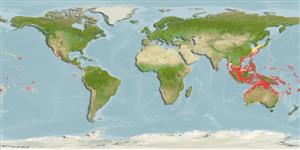Common names from other countries
Environment: milieu / climate zone / depth range / distribution range
Ecología
Asociado a arrecife; rango de profundidad 0 - 100 m (Ref. 99185). Tropical
Indo-West Pacific.
Length at first maturity / Tamaño / Peso / Age
Maturity: Lm ? range ? - ? cm Max length : 5.5 cm TL macho / no sexado; (Ref. 3145)
Inhabits shallow waters, common in reef flats (Ref. 3510).
Life cycle and mating behavior
Madurez | Reproducción | Puesta | Huevos | Fecundidad | Larva
Some members of the order Stomatopoda pair for life and some come together only to mate. Males produce sperm ducts rather than spermatophores; females can brood a maximum of 50,000 eggs. Life cycle: Eggs hatch to a planktonic zoea which lasts for 3 months.
Ahyong, S.T. 2001. (Ref. 3099)
IUCN Red List Status (Ref. 130435)
CITES status (Ref. 108899)
Not Evaluated
Not Evaluated
Threat to humans
Harmless
Human uses
| FishSource |
Herramientas
Más información
Age/SizeCrecimientoLength-weightLength-lengthMorfologíaLarvaAbundancia
Fuentes de Internet
Estimates based on models
Preferred temperature
(Ref.
115969): 22.3 - 29.1, mean 28 (based on 1776 cells).
Vulnerability
Low vulnerability (10 of 100).
